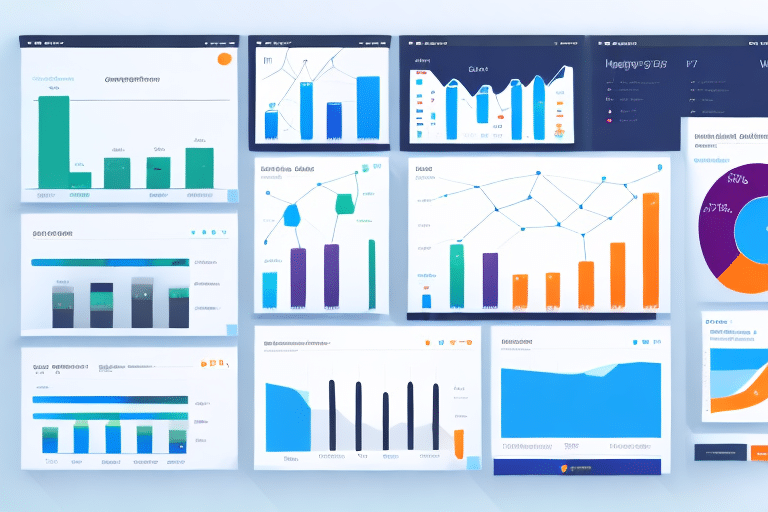Maximizing Your Conversion Rates Through Conversion Optimization
In today's competitive online marketplace, optimizing your website's conversion rate is essential for businesses looking to grow and succeed. Conversion optimization refers to the process of improving your website's ability to turn visitors into customers, which can significantly increase your revenue and profitability. In this article, we will explore the fundamentals of conversion optimization and offer insights on creating effective strategies to maximize your conversion rates.
Understanding the Basics of Conversion Optimization
The first step in optimizing your website's conversion rate is to understand the basics of conversion optimization. This includes knowing the key metrics that define success, such as conversion rate, bounce rate, and average session duration. Conversion rate is the percentage of visitors who take a desired action on your website, such as making a purchase or filling out a contact form. Bounce rate, on the other hand, is the percentage of visitors who leave your website without taking any action. Average session duration refers to the amount of time visitors spend on your website before leaving or completing an action.
Another important aspect of conversion optimization is understanding your target audience. You need to know who your ideal customer is, what their pain points are, and what motivates them to take action. This information can help you create targeted messaging and design a user experience that resonates with your audience. Additionally, conducting user testing and gathering feedback can provide valuable insights into how your website can be improved to better meet the needs of your visitors.
Identifying the Right Conversion Metrics for Your Business
Once you understand the basics of conversion optimization, the next step is to identify the right conversion metrics for your business. This will depend on your specific goals and objectives. For example, if you operate an e-commerce website, your main goal may be to increase sales. In this case, your conversion rate would be the most important metric to track.
However, if your business is focused on lead generation, then your conversion metric would be the number of leads generated. On the other hand, if your business is focused on increasing website traffic, then your conversion metric would be the number of visitors to your website. It is important to identify the right conversion metric for your business, as this will help you to measure the success of your conversion optimization efforts and make data-driven decisions to improve your website's performance.
Analyzing Your Website's User Behavior to Increase Conversions
In order to improve your conversion rate, you need to understand the behavior of your website's visitors. This includes analyzing which pages are most visited, which pages have the highest bounce rate, and which pages have the highest conversion rate. By understanding this data, you can make informed decisions about how to optimize your website for improved conversions.
One effective way to gather data on user behavior is through the use of heat maps. Heat maps provide a visual representation of where users are clicking and scrolling on your website. This information can help you identify areas of your website that are receiving the most attention and areas that may need improvement. Additionally, you can use A/B testing to compare different versions of your website and see which version leads to higher conversion rates. By regularly analyzing user behavior and making data-driven decisions, you can continuously improve your website's performance and increase conversions.
Creating Compelling Calls-to-Action for Improved Conversions
Your website's calls-to-action (CTAs) are critical for driving conversions. A CTA is a button or link that encourages visitors to take a specific action, such as making a purchase or subscribing to a newsletter. To improve your conversion rate, it's essential to create compelling CTAs that are clearly visible, easy to understand, and relevant to your audience.
One effective way to create compelling CTAs is to use action-oriented language that creates a sense of urgency. For example, instead of using a generic "Submit" button, try using "Get Your Free Ebook Now" or "Limited Time Offer - Buy Now". Additionally, using contrasting colors for your CTA buttons can make them stand out and catch the visitor's attention. Finally, it's important to test and analyze the performance of your CTAs regularly to see what works best for your audience and make adjustments accordingly.
Optimizing Your Landing Pages for Better Conversion Rates
Landing pages are the pages of your website that visitors land on after clicking on an ad or search result. To increase your conversion rate, it's important to optimize your landing pages for maximum effectiveness. This involves using clear and concise messaging, providing relevant and high-quality content, and including a strong call-to-action.
Another important factor in optimizing your landing pages is to ensure that they are mobile-friendly. With the increasing use of mobile devices, it's crucial that your landing pages are easily accessible and readable on smaller screens. This means using responsive design and avoiding large blocks of text or images that may be difficult to view on a mobile device. By making your landing pages mobile-friendly, you can improve the user experience and increase the likelihood of conversions.
Implementing A/B Testing to Fine-Tune Conversion Strategies
A/B testing is a powerful tool for optimizing your conversion rate. This involves creating two versions of a page or element on your website and testing them to see which performs better. By continuously testing and refining your conversion strategies, you can improve your website's performance and increase your conversion rate over time.
One important aspect of A/B testing is to ensure that you are testing only one variable at a time. This means that you should only change one element on the page, such as the color of a button or the placement of a form, and keep everything else the same. This allows you to accurately measure the impact of that one change on your conversion rate.
It's also important to have a large enough sample size for your A/B test to ensure that your results are statistically significant. This means that you need to have enough visitors to your website to ensure that the results you see are not just due to chance. A good rule of thumb is to aim for at least 100 conversions per variation before making any conclusions about which version is better.
Using Heat Maps and Click Tracking to Improve User Experience
Heat maps and click tracking tools can provide valuable insights into how visitors interact with your website. Heat maps show which areas of your website are most frequently clicked on, while click tracking tools show where visitors are clicking on specific videos, images, or other elements. By using these tools to monitor user behavior, you can identify areas where your website's user experience can be optimized for better conversions.
One of the benefits of using heat maps and click tracking tools is that they can help you identify areas of your website that are not receiving enough attention from visitors. By analyzing the data provided by these tools, you can determine which areas of your website need to be redesigned or repositioned to increase engagement and improve user experience.
Another advantage of using heat maps and click tracking tools is that they can help you identify potential issues with your website's navigation. If visitors are frequently clicking on elements that are not clickable or are having difficulty finding the information they need, you can use this information to make adjustments to your website's navigation and improve the overall user experience.
Leveraging Social Proof to Boost Credibility and Conversions
Social proof is the concept that people are more likely to take action when they see others doing the same thing. To leverage social proof in your conversion optimization strategy, you can use customer testimonials, ratings, and reviews to build credibility and trust with your audience. This can be a powerful tool for increasing your conversion rate and driving meaningful results for your business.
One effective way to use social proof is by showcasing the number of customers or users who have already taken the desired action, such as purchasing a product or signing up for a service. This can create a sense of urgency and FOMO (fear of missing out) among your audience, encouraging them to take action as well.
Another way to leverage social proof is by featuring endorsements or partnerships with well-known individuals or brands in your industry. This can help to establish your business as a trusted and respected authority, and can also attract new customers who are fans or followers of the endorsing party.
Streamlining Checkout Processes for Increased Sales and Revenue
If you operate an e-commerce website, optimizing your checkout process is essential for increasing sales and revenue. This involves simplifying the checkout process, providing clear and concise instructions, and minimizing distractions that could cause visitors to abandon their purchase.
- Simplify Form Fields: Reduce the number of fields customers need to fill out.
- Guest Checkout: Allow customers to check out without creating an account.
- Clear Progress Indicators: Show customers how many steps are left in the checkout process.
- Multiple Payment Options: Offer various payment methods to cater to different preferences.
By streamlining the checkout process, you can reduce friction and make it easier for customers to complete their purchases, thereby increasing your conversion rates.
Optimizing Email Campaigns for Improved Conversion Rates
Email marketing is a powerful tool for driving conversions and building relationships with your audience. To optimize your email campaigns for improved conversion rates, it's important to:
- Create Compelling Subject Lines: Capture your audience's attention and encourage them to open your emails.
- Provide Valuable Content: Ensure that your emails offer something of value to your subscribers, such as exclusive offers, useful information, or personalized recommendations.
- Include Clear and Actionable CTAs: Guide your subscribers on the next steps you want them to take.
- Segment Your Audience: Tailor your emails to different segments of your audience based on their behaviors and preferences.
By implementing these strategies, you can enhance the effectiveness of your email campaigns and achieve higher conversion rates.
Conducting Regular Audits to Identify Conversion Roadblocks
To maximize your conversion rate, it's important to conduct regular audits of your website to identify any roadblocks that may be preventing visitors from taking action. This could include issues with load times, broken links, or poor user experience. By identifying and addressing these issues, you can improve your website's performance and increase your conversion rate.
Here are some key areas to focus on during your audit:
- Site Speed: Use tools like Google PageSpeed Insights to assess and improve your website's loading times.
- Mobile Responsiveness: Ensure that your website functions well on all devices.
- Navigation: Check for intuitive navigation structures that make it easy for users to find what they’re looking for.
- Content Quality: Evaluate the relevance and quality of your website content.
- Conversion Funnels: Analyze each step of your conversion funnel to identify and fix drop-off points.
Investing in Tools and Technology for Better Conversion Optimization
Investing in the right tools and technology can greatly enhance your conversion optimization strategy. This includes:
- Analytics Tools: Use platforms like Google Analytics to monitor your website's performance and user behavior.
- A/B Testing Software: Utilize tools such as Optimizely or VWO to conduct A/B tests and experiment with different conversion strategies.
- Heat Map and Click Tracking Tools: Implement solutions like Hotjar or Mouseflow to gain insights into user interactions on your website.
- CRM Systems: Integrate Customer Relationship Management systems to better manage and analyze customer interactions.
By leveraging these technologies, you can gain deeper insights and implement more effective conversion optimization strategies.
Working with Experts to Develop Tailored Conversion Strategies
Finally, working with experts can be an effective way to develop tailored conversion strategies that are specific to your business and goals. Whether you partner with a digital marketing agency or a freelance consultant, collaborating with professionals can help you navigate the complexities of conversion optimization and achieve your desired results.
Experts bring specialized knowledge and experience, allowing you to implement advanced strategies and avoid common pitfalls. They can also provide an objective perspective, identifying opportunities for improvement that you might overlook.
Measuring Success through Data-Driven Analytics and Reporting
To measure the success of your conversion optimization strategy, it's important to use data-driven analytics and reporting tools. This involves tracking key metrics such as conversion rate, bounce rate, and average session duration, and using this data to make informed decisions about how to optimize your website for improved conversions. By continuously measuring and refining your strategy, you can achieve meaningful results and maximize your conversion rate over time.
Implementing regular reporting practices allows you to:
- Monitor Progress: Keep track of your performance against your conversion goals.
- Identify Trends: Detect patterns in user behavior and conversion rates over time.
- Inform Decision-Making: Use data insights to prioritize optimization efforts and allocate resources effectively.
- Demonstrate ROI: Showcase the impact of your conversion optimization initiatives to stakeholders.
Conclusion
Maximizing your conversion rate through conversion optimization is essential for businesses looking to grow and succeed in today's competitive online marketplace. By understanding the basics of conversion optimization, identifying the right conversion metrics for your business, and implementing effective strategies such as A/B testing, heat mapping, and CTA optimization, you can significantly increase your revenue and profitability. Whether you work on your own or partner with experts, it's important to use data-driven analytics to measure your success and continuously refine your conversion strategy over time.









